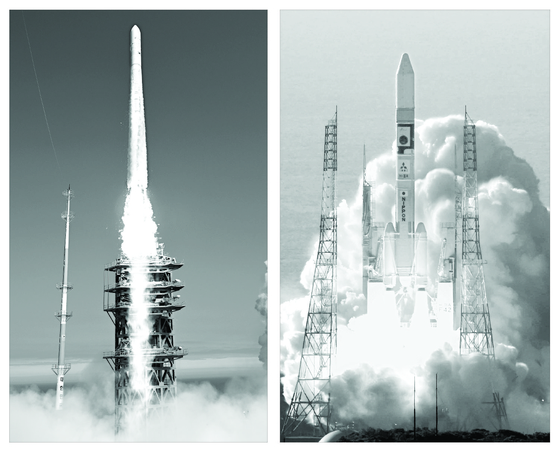America’s double standard on rockets

The author is an editorial writer of the JoongAng Ilbo.
South Korea and the United States vowed to enhance their alliance in space programs in a statement after a summit in Seoul in May. South Koreans would join U.S.-led space exploration, including the Artemis Project aimed at establishing a permanent self-supporting base on the moon. Washington also reaffirmed support to Seoul of the Korean Positioning System (KPS) for the satellite-based navigation.
But the space alliance will likely be limited to rhetoric. In reality, South Korea cannot rely on U.S. support. According to sources from the science community, the Ministry of Science and ICT officially requested that revisions of the U.S. regulatory regime called the International Traffic in Arms Regulation (ITAR) be included in the summit agenda. Washington flatly rejected the request.
ITAR regulates export of U.S. technologies for defense and military purposes. Under the regulation, South Korea cannot launch a satellite with U.S. technologies or parts without the approval of Washington. The law won’t matter if Korea has fully domestic satellites. Korea still relies on the U.S. for core technologies for satellites. Experts believe Washington still disapproves of South Korea gaining independent rocket technology that can be used to launch intercontinental ballistic missiles like North Korea. America has stayed aloof to South Korean endeavors to self-develop space launch vehicles. South Korea had to turn to Russia to advance and launch space vehicles through a space cooperation treaty in 2003.
The U.S. on the other hand helped its war enemy Japan in rocket missions. Why not South Korea, which has been a longstanding ally?
Japan’s history of space and rocket programs can help answer the question. Japan began the so-called N project of liquid rockets in 1969. It received technology transfer from McDonnell Douglas on the design, production and launch system technology from its Delta rockets. Japan was authorized to produce license-based derivatives of Delta rockets on the condition that Japan keeps core technologies confidential. In September 1975, Japan succeeded in launching its first N (standing for Nippon) rocket. In 1994, the country successfully launched its own liquefied hydrogen-fueled rocket, the H2, to join the ranks of space power.

In the introduction of a translated Japanese book on the conditions of the rocket project success in Japan, Kim Young-min, a space policy expert and professor of emeritus at Hanyang University, wrote that the U.S. had assisted Japan in space development as Japan — thanks to its technology level — would have achieved self-sufficiency in space development with or without help from the U.S. International conditions also worked in Japan’s favor. Tokyo began pursuing space project after China successfully carried out a nuclear test in 1964 and moved onto space development. Washington thought it would be better to control Japan by lending its technology instead of leaving the country make strides with homegrown technology.
South Korea on the other hand had to purse its rocket development without the assistance of the United States. Under general-turned-president Park Chung Hee, South Korea succeeded in developing solid-fueled rocket NHK-1, which flew 200 kilometers (124 miles) in 1978. In his memoir, the late Hong Yong-shik, a professor of space engineering at Inha University, recalled the project aimed at flying a missile 500 kilometers with payload weighing 500 kilograms. The ultimate goal was a rocket that can carry a nuclear warhead. President Chun Doo Hwan, who came to power through a military coup, shuttered the Agency for Defense Development (ADD), which spearheaded rocket development. Chun had to comply with U.S. wishes in order to gain legitimacy of his coup-won regime. Cho Kwang-rae, former head of the Korea Aerospace Research Institute (KARI), recalled how his superiors were shocked at the decision and likened the event to a revolt.
After the launch in 1987 of the U.S.-led Missile Technology Control Regime (MTCR) designed to control the proliferation of missiles and missile technology, access to the technology became more or less impossible. But Japan and another seven countries already equipped with rocket launch technology were exceptions. South Korea created the KARI in 1989 and embarked on developing space launch vehicles starting with the single-stage solid-fueled KSR-1 in 1990. But the door to technology transfer was already closed. Washington also has been against — and refrained from — backing Seoul’s development of space launch vehicles as its rationale to oppose North Korea’s ICBM development could weaken.
After much upheaval, South Korea has finally succeeded in firing the three-stage Nuri last month. Could the country get the blessing from America to amend the ITAR for further advance in space projects? Experts are mixed. Hwang Jin-young, a researcher at KARI, said he was surprised by the U.S. agreement to revise the bilateral missile guidelines. Since the country can launch a homemade space launch vehicle, it can raise hope for further easing in the ITAR, he added.
But, one anonymous space expert disagreed. India had been the sole exception to the ITAR under MTCR. It was made an exception because it formed a strategic partnership with America to contain China. Unless South Korea can do the same, it must be fully independent on space launch vehicle technology, the expert added.










with the Korea JoongAng Daily
To write comments, please log in to one of the accounts.
Standards Board Policy (0/250자)